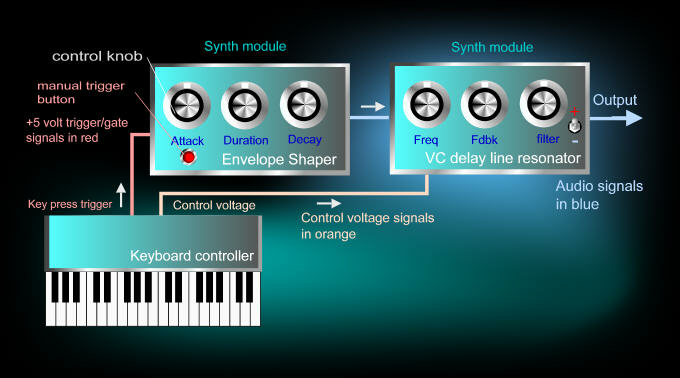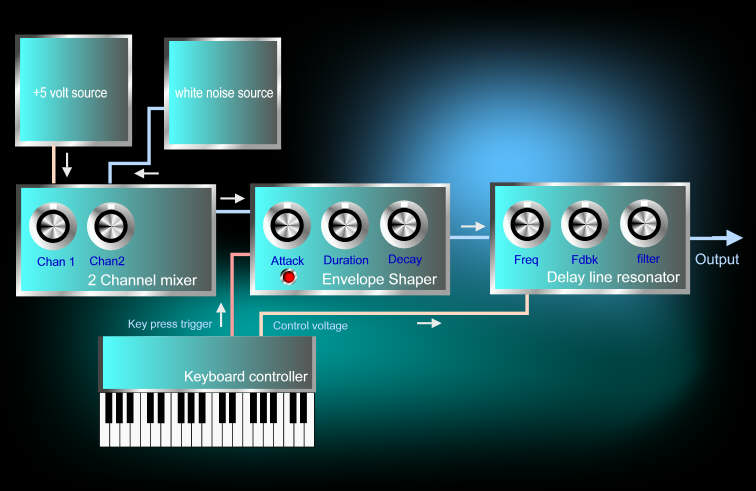
Acoustic Modelling 2.....
BLOCK DIAGRAMS..
I’ve drawn all the basic patches in the form of block diagrams like the one below for clarity. Audio connections are shown in light blue, control voltage connections in salmon red and trigger signals in light brown. They are the patch cords but laid out neatly! Arrows show the signal flow.

......ACOUSTIC ANALOGUE MODELLING: THE MODELS......
PLUCKED STRINGS...
This, shown below, was the first model I constructed. A mainframe computer program (by Kevin Karplus and Alex Strong) had already been written to demonstrate that a string tone could be generated by loading a program register with random numbers and using this to excite a looped digital delay line array of computer registers. The nearest to this in the analogue world I reckoned was to excite a analogue delay line with pulses of a random signal (noise) . This seemed therefore to be a good starting point for building block ideas and general system proving. I therefore started with this...

How the plucked string model works....
My basic analogue string model above has some similarities to the computer one but the version above, uses standard analogue synthesiser functions to pulse sharp bursts of noise into my special delay line module.
First the sound of a pick is needed. White noise and a fixed voltage source are fed into a mixer module and then into an envelope shaper. The controls are adjusted to produce a very short burst of noise; (all frequencies) along with a transient voltage step (kick). This is a very simple model of the sound energy produced the moment you pick the string. (The shorter the noise burst the ‘thinner’ the pick). This pick energy is fed into the delay line module .
It’s the looped delay feedback that models the actual string. The delay just simply represents the time it takes for a vibrating string to vibrate through one cycle. For a 100Hz bass note, this would be 10 mlliseconds (1/100 of a second). The important feedback loop setting round the delay controls the amount of noise energy burst that gets cycled round the delay loop (‘string’ sustain). The nearer feedback is set to unity gain the longer the sound goes round and round the loop before dying away.
As the noise burst circulates round and round the delay loop, noise frequency components (all frequencies) progressively get organised; quickly favouring those that fit this loop time nicely. Those that fit nicely sustain well and those that don’t, quickly die away as they get averaged out.
First the sound of a pick is needed. White noise and a fixed voltage source are fed into a mixer module and then into an envelope shaper. The controls are adjusted to produce a very short burst of noise; (all frequencies) along with a transient voltage step (kick). This is a very simple model of the sound energy produced the moment you pick the string. (The shorter the noise burst the ‘thinner’ the pick). This pick energy is fed into the delay line module .
It’s the looped delay feedback that models the actual string. The delay just simply represents the time it takes for a vibrating string to vibrate through one cycle. For a 100Hz bass note, this would be 10 mlliseconds (1/100 of a second). The important feedback loop setting round the delay controls the amount of noise energy burst that gets cycled round the delay loop (‘string’ sustain). The nearer feedback is set to unity gain the longer the sound goes round and round the loop before dying away.
As the noise burst circulates round and round the delay loop, noise frequency components (all frequencies) progressively get organised; quickly favouring those that fit this loop time nicely. Those that fit nicely sustain well and those that don’t, quickly die away as they get averaged out.
Since all ‘string’ overtone frequencies fit perfectly to multiples of the basic loop time, they also sustain or resonate well as in a real string. This causes a harmonically rich pitched note of a period the same as the delay time to be created or organised from the noise energy. This is the key string resonance effect. You can hear this working in the first part of the string sound example on the next page. First you hear just a repeated noise burst: the pick on it’s own. Then the delay feedback is increased and the loop starts to ring. You can still hear the noise at the start and the organised pitched note being created from it. It sounds electronic yet acoustic too and it’s a really nice sound, but maybe just a little too perfectly electronic?
| Home | Previous page | Next page |
Using a modular analogue synthesiser